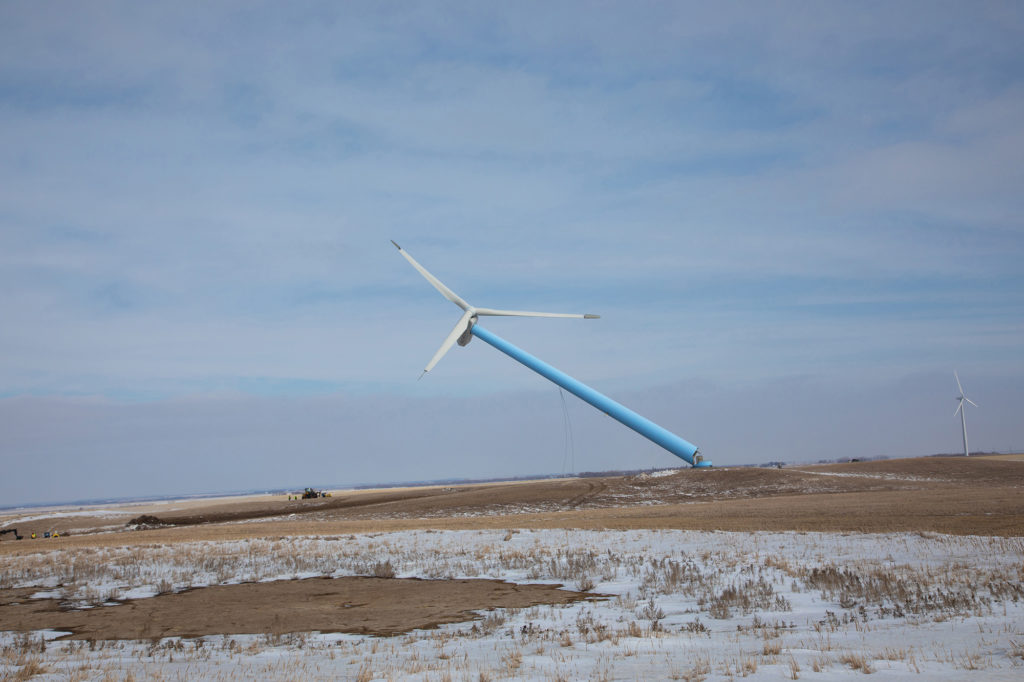
Two wind turbines that provided a wealth of utility-scale renewable energy and hands-on experience to Basin Electric Power Cooperative were toppled in March, 20 years after they first became curious new features on North Dakota’s landscape.
“They were at the end of their useful life, and parts to keep them running are no longer available,” said Joe Fiedler, Basin Electric’s manager of distributed generation.
Commissioned in November 2002 and affectionately dubbed “Willy” and “Wally,” the two Nordex wind turbines were designed to produce 1.3 megawatts of electricity each and were the first two constructed for the Bismarck-based generation and transmission cooperative. Over their lives, they produced nearly 135 million kilowatt-hours of electricity and provided key experience and training for technicians supporting Basin Electric’s renewable energy operation.
The March 14 demolitions used a “chop and drop” technique, felling the structures like giant trees.
“A contractor ran two lines up to apply pressure to [each] tower and then used cutting torches to cut the bases so they could be pulled over,” said Patrick Hurt, supervisor of operations and maintenance for Basin Electric’s Prairie Winds generation facilities. “They made a heck of a boom when they hit the ground.”
Basin Electric’s initial foray into wind energy was considered ambitious and even risky at the time.
“Wind was met with a fair amount of skepticism in the beginning,” said Basin Electric Member Services Specialist Jeremy Woeste, recalling how some industry veterans questioned whether even demonstration projects were a waste of time and money.
“It’s an intermittent resource, but we had member co-ops that had an interest in finding out if this would work. Those turbines gave us an opportunity to determine if we could add wind to our generation portfolio and what we needed to learn to make the technology viable and affordable.”
The G&T now owns 189 wind turbines in North Dakota and South Dakota and contracts for production from nearly 950 additional turbines located in four Upper Midwest states, where some of the nation’s most reliable conditions exist for utility-scale wind operations.
“We have definitely been able to rely on the wind development within our service territory,” said Becky Kern, Basin Electric’s vice president of resource planning and rates.
“Wind technology has significantly improved and matured during the last decade, and we work with developers when it makes good economic sense for our members.”
Being wind power pioneers has given Basin Electric crews unique opportunities to build their skills maintaining turbines, which run on an array of gears and sensors that must be constantly monitored and calibrated.
“We have about one technician for every 10 turbines,” said Joe Fiedler, Basin Electric’s manager of distributed generation. “We don’t do any of the major repairs like dropping a blade or doing a gearbox exchange, but our crews do all the other troubleshooting and maintenance on the wind turbines and collectors.”
Basin Electric has worked with some of its purchase power providers to repower some older turbines, refitting them with newer systems to increase their efficiency and prolong their use.
But as some of its oldest units are taken out of service, the G&T plans to return the land to its original use. That includes removal of the turbine and blade assemblies plus the 25,000 pounds of steel and 188 cubic yards of concrete used to support each structure.
“Basin Electric advocated responsible reclamation practices long before it was required by law, and our commitment to a clean environment continues today,” Fiedler said. “This project, like all of our others, includes a decommissioning plan that supports returning the land it was built on to its traditional use.”
Most of Willy and Wally’s original structures are now gone, cut down and hauled away for refurbishment or scrap. But the knowledge and experience they helped provide live on as the foundation of Basin Electric’s ambitious renewables program.
“Our commitment to wind dates back 20 years. Since then, wind has grown to be nearly a quarter of our entire resource portfolio, and we’ve been able to meet a 50% load growth largely with renewable resources,” Kern said. “That wouldn’t have been possible without the knowledge we gained from those original two turbines.”
Derrill Holly is a staff writer at NRECA.